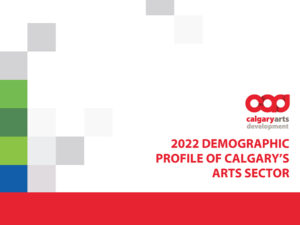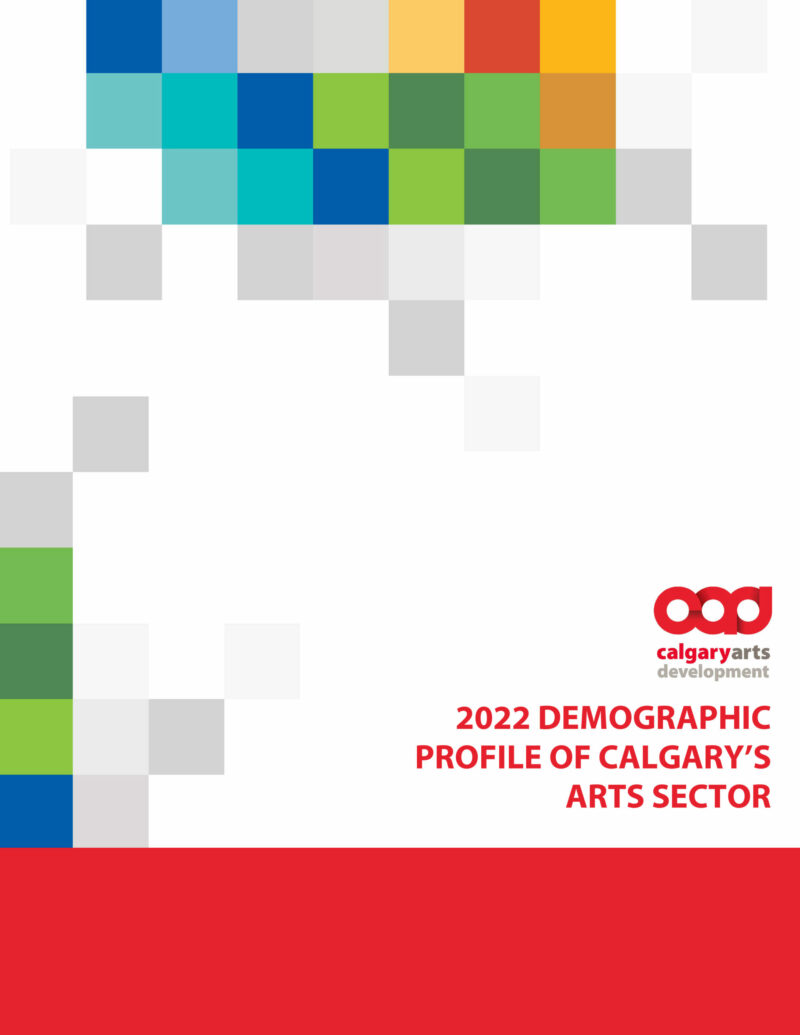2022 Demographic Profile of Calgary’s Arts Sector
In summer 2021, Calgary Arts Development undertook a demographic survey of Calgary’s arts sector, as represented by the 168 not-for-profit arts organizations that receive annual operating funds from Calgary Arts Development. This survey was an update to the 2017 Equity, Diversity and Inclusion survey.
The purpose of the survey was to provide the updated detailed data necessary to construct a demographic profile of Calgary’s arts sector. The 2021 survey was undertaken by Calgary Arts Development and administered by SMU DataArts.
Key Findings
- The arts sector continues to be significantly less racially diverse than the population of Calgary. While 41% of Calgarians identify as visible minorities, only 21% of those participating in the arts share that identity. Those who identify as a visible minority are more likely to hold entry-level positions and are less likely to earn over $59K per year than those who are white.
- While women make up the majority of the sector according to gender (59%), those who identify as male are still more likely to hold leadership positions either as board members or senior management. Those who identify as male are also more likely to earn over $50,000 per year. Those who identify as non-binary gender identities are more likely to have artistic and entry level roles.
- Indigenous representation in the sector is nearly identical to representation in the general population when compared to census data. While this movement is positive, participation numbers are not equal within organizations. Indigenous individuals are far more likely to hold roles in organizations at the entry or individual contributor level rather than at the senior or mid-level management levels.
- While the federal census does not capture 2SLGBTTIQ+ data at the local level, those identifying as 2SLGBTTIQ+ are well represented in the arts sector, though they are less likely to earn over $50,000 per year than heterosexual respondents.
- Income for those working in the arts lags those working in other industries. Only 32% of those working for arts organizations (excluding volunteers) make over $50,000 per year. As well as earning a low wage in the sector, it is difficult to find full-time work. Of those working for arts organizations, only 44% earn the majority of their income in the arts.
COVID-19 Survey Impact
This survey was fielded in 2021, when COVID-19 was still significantly impacting organizations’ staffing, volunteer and programming levels.
Some shifts in responses from 2017 may be the result of layoffs during the pandemic. A reduction of entry level positions may skew results like income to be higher due to low-paying positions being vacant. The pandemic also significantly impacted the number of volunteer positions currently available in the sector. Future versions of this survey will identify whether these are long-term shifts in the sector or temporary anomalies.
With many organizations having reduced or no programming taking place, Calgary Arts Development was advised that it was more difficult to engage volunteers whose connection to organizations had become irregular. It was also more difficult to survey staff and artists who found themselves furloughed during this time.
Despite the many challenges in sharing the survey during a pandemic, 4,595 completed voluntary self-disclosure forms were submitted, a 45.8% increase from the 3,151 completed forms in 2017. In part this can be attributed to the quality of the DataArts platform being used in this version of the survey, as well as the increased familiarity organizations now have with the survey in its second iteration.
Report Timing
It is beneficial to interpret basic demographic data when possible in comparison to federal census data at the Calgary level. While this survey was completed in mid-2021, releasing this report was significantly delayed while waiting for the 2021 federal census data to be published in late-2022.
Federal census results for Calgary can be viewed by visiting www12.statcan.gc.ca/census-recensement.
Download the full publication:

